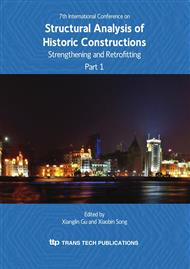p.697
p.703
p.709
p.715
p.721
p.727
p.735
p.741
p.747
Seismic Assessment of Monastery of Stoudios (Imrahor Mosque) in Istanbul
Abstract:
Monastery of Stoudios, dated back to the reign of Eastern Roman Empire, is known to be the oldest surviving –albeit partially- religious building in Istanbul. During sixteen centuries, the building has been exposed to several earthquakes, fires and other minor disasters which have caused considerable damages and partial destruction in some of its sections. As a part of a general master plan for the structural condition assessment of historical buildings and monuments of Istanbul, this study aims to evaluate the seismic resistance of the monastery against future excitations. The expected failures and corresponding preventive/controlling repairs and strengthening measures will also be discussed in the article.
Info:
Periodical:
Pages:
721-726
Citation:
Online since:
October 2010
Authors:
Price:
Сopyright:
© 2010 Trans Tech Publications Ltd. All Rights Reserved
Share:
Citation:



